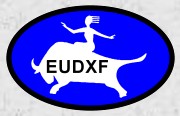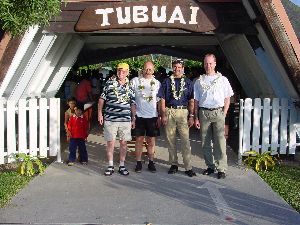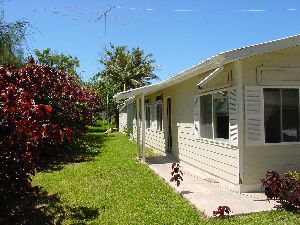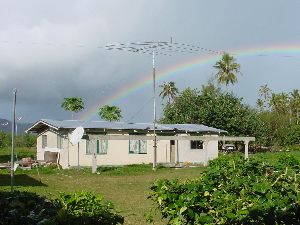The Autral Islands DXpedition by DF6IC, DJ4OI, DL1IAN and DL3GA, September/October 2003
Sponsored by:



___ Sunday, September 14
It's a relaxed quarter past ten in
the morning when we meet at Richard's place. A chartered mini-bus
takes us to Frankfurt airport. The longest lineup in front of a
Lufthansa check-in counter costs us an hour – but we can
affort it. Our luggage is checked all the way through to Tahiti.
Sounds good, but Andy doubts that this will really happen. The
short hop to London Heathrow is done in no time and we spend more
time in lineups (Brits love lineups, we believe...). Weather is
nice to us this time, gorgeous views on London, Greenland,
northern Canada and some US-states in call area 7 make window
seats attractive. As expected, we have to claim and re-check all
our luggage, making the stopover in Los Angeles unnecessarily
hectic and chaotic. Only seconds after our boarding, the doors of
the aircraft are shut and off we go towards Papeete, Tahiti. We
all try to get some sleep during the eight-hour flight.
___ Monday, September 15
After the on-schedule landing and welcome with flowers and folk music at 02.40 in the morning, we have to find out that two pieces of luggage are missing. This seems to happen frequently – no wonder if we look back at what happened in Los Angeles. At 06.30, we take a taxi to downtown Papeete and check in with our hotel. After a short nap, we walk to the Haut-Commissariat to pick up our licenses. The friendly lady in the office welcomes us and starts handing out the papers to us. Joachim's call is wrong, but after only a few minutes he receives the corrected version. We decide to take it easy for the rest of the day and work on our 12-hour jet lag.
___ Tuesday, September 16
We are slowly coming back to life. After breakfast, we explore downtown Papeete and its commercial infrastrucure. There is a shop carrying electronic parts. If our baggage doesn't show up before we fly to Tubuai, we will try to replace some things like the CW keyer cable and coax. Back at the hotel however, we get the message that the baggage was found. It had remained in the aircraft and went to Auckland, New Zealand. It should be back before we leave for Tubuai. We hope so... We also work off some „duties“ like writing picture postcards.
___ Wednesday, September 17
Our lost baggage comes back this morning, everything is in good shape. After another downtown breakfast, the mini-bus taxi takes us to the airport. Check-in for our flight starts quite late and there is a problem with the overweight. Finally we have to pay for it, but the rate is much lower than what we had heard from our travel agent back home. Another surprise is that we land on Raevavae island before we move on to Tubuai. The runway is a man-made strip in the ocean and was only opened last November. After another 30 min flight, we (and all our luggage) arrive at our final destination of this trip – Tubuai island. Our host Karine welcomes us with the garlands so typical for the islands in the Pacific. She takes us to the guest house where we are going to spend the next two weeks. We explore its furnishing and complete some indoor preparations for the radio operation. To the north-east (Europe), there are two mountains in front of us. But it looks like there is a gap between them, wide enough to get through. Finally we go to our water beds, a „new one“ for most of us...

DJ4OI,
DF6IC, DL1IAN, DL3GA just arrived
___ Thursday, September 18
Antenna work is started even before breakfast. The two 5-element log-periodics need to be assembled, and erecting them in the windy weather requires the help of every person available, even our host's son Mata Uira, who lives next door. His skills and equipment help to solve most of the problems we face. Finally it's time to go on the air and check what we can work from here. No surprise that we work many W6 and W7 stations, and many JAs also. Stations from South America are also loud. But we even do get through to Europe, so there is hope. The best time seems to be around 06.00 UTC, we shall be back for more QSOs at this time of the day. One IC-706 dies, no signal out, no reception either. Fortunately, it comes back to life after a CPU reset. The weather stays windy all night, and for an hour it rains like crazy. QSO count: 1009
___ Friday, September 19
The morning doesn't bring good condx with it. Especially the upper bands appear rather dead and the demand is not overwhealming. So we use the time to work on the remaining antennas for the lower bands. Again, Mata Uira's helping hand speeds everything up a lot. So we have all antennas playing for the weekend, except for the 6m quad – no coax left. We'll bring it up when 80m is worked off. In the evening, we check the low band dipoles with promising results on 30m, but 40 doesn't work very good and 80 is dead. The 30m antenna is in a good direction for JA, but also many stations from the Americas and even a few EUs make it into the log. Many more should follow once it's optimized. The bands are rather quiet all day and all night, allowing operation in a fast and smooth manner. Roughly half of the QSOs are in CW. We are ready to dive into the weekend. QSO count: 2240.
___ Saturday, September 20
Much interest in our operation today. The early morning is not really busy, but as the upper bands open towards the north-east (USA), the pileups come up in CW and SSB. Just the attempts for RTTY on the WARC bands fail. Hmmm... Anyhow, the ops are quite exhausted at the end of this day, and it's only half way through the weekend. One problem is that there is strong interference between the stations when both LP5s are directed to JA. They are almost in line this way, whereas the US and EU pose no problems as the antennas „look“ there in a parallel pattern. QSO count: 4847.
___ Sunday, September 21
No baguette has been delivered for breakfast ! Good thing we bought some extra bread yesterday. We get right back to the pileups and find them a little weaker than yesterday, but still very intense at times, most of all in SSB. The pileups from JA are remarkably low, as it's already monday there and people are at work rather than working DX. An outstanding tuna steak dinner compensates for the breakfast flop. QSO count: 6671.
___ Monday, September 22
We try to take it easy today, as the weekend was pretty exhausting for the ops. Our old pickup truck's starter quits while we are at the grocery store - the type of trouble we don't need here. But the store's people are very friendly, call our host on the phone to let them know about this and drive us (and our buy) to our house in their truck. The first attempts to get going with SSTV are lengthy – a cable must be replaced and we don't find a QSO partner for the finetuning. Later, we notice that the conditions are improving dramatically. There are growing pileups from the US and JA and we are frequently asked for the low bands – smart ops who anticipate what should be possible today. The upper bands are open to Asia till after dark and produce monster pileups in SSB. In over two hours, some 180 european stations get into the 20m CW log. The callers clearly appear along the greyline. We scrap our plans to catch up with sleep and work the low bands as long as we can handle without falling asleep at the radio. The first run on 40m CW nets over 200 QSOs in 100 minutes, the pileup is terrific. QSO count: 8409

One
of the two LP5 antennas, heading USA/EU
___ Tuesday, September 23
Our host Karine brings back the repaired truck and stays for a little chat. She looks into our sleepy faces and wonders what kind of party we were on last night. We learn more details about the Austral Islands and the inhabitants. After the sunny monday, the weather has turned back to breezy and cloudy. The conditions are way down as compared to yesterday. So we can finally take some rest from the radios. One group goes to the beach for some swimming, the others explore the island off the coastal road. DJ4OI's LP5 antenna suddenly spins with the wind. One guy wire and the directional ropes are broken. Looks like next door's dogs found something new to play with. The activity on the upper bands is rather low, so there is time to respond to a few special requests like 10m FM. But there is an evening opening to EU which is covered in SSB today. We find a battery charger to be the reason for some S9 noise on the bands below 10 Mhz. With clear bands, we trade sleep for more QSOs here as the demand for 40m and 80m is still high. QSO count: 10081

The
other LP5 at Mata Uira's house
___ Wednesday, September 24
Bad weather today, it's overcast, windy and cool. But unexpectedly, the pileups are back. We copy a ARRL DX bulletin broadcast in RTTY, saying the solar activity was increasing. Good for us. This evening, we take advantage of a long opening on 17m towards Asia. After the CW run, we continue in SSB and the conditions are so good that we ask some JA stations for a start in SSTV again. The first six QSOs are then taking place on 15m. After that, we get through to EU on 40m SSB, while 20m CW doesn't really work. But it does later in SSB, another surprize. Lesson learned: Propagation prediction is nice, but reality is sometimes different. Overall, the day is the second busiest – surprizing for a wednesday. QSO count: 12344
___ Thrusday, September 25
Another low band run into the early morning brings QSOs to those who didn't get one the nights before. But we feel that this was it, next night – for a change – we will sleep again. The conditions on the bands seem to be worse, too. DJ4OI takes a walk into the island and finds a nice restaurant – maybe the right place for a last dinner before we will leave. On the way back, he gets lost and finds himself near the grocery store – too far to walk back. But no problem, hitch-hiking is quick and reliable here. Just after noon, the gusty winds die and turn into continuous rain. Only a longer RTTY run on 12m and ongoing demand for SSB holds our QSO rates high. QSO count: 13697
___ Friday, September 26
No more night shifts, we recharge our „batteries“ for the upcoming weekend. Some SSB before breakfast, but after that the station is completely dead. The dogs have nibbled the Aircell 7 cable into pieces. After installing new plugs to connect the loose ends, we hang it high, out of the dogs' range. As anticipated, the higher bands bring good QSO rates to Asia today. At midnight UTC, just after lunch here, we start taking part in the RTTY contest. The QSOs are mostly with USA and Japan, but the rest of the world takes their chances. The weather is a combination of gusty winds and rain – no sun today. The water seems to affect the antennas. SWR has become worse for most of them and there is QRN-like noise on some. We are not sure if the reason is a thunderstorm or something else. The 30m dipole is the worst, it is hardly useable. However, when the RTTY station gives up 40m, CW nets lots of QSOs here – as if they had waited for us. We are talked into QSY to 30m again – and in spite of the noisy antenna, another hundred QSOs are logged here. QSO count: 15082

Looks
like Aircell 7 contains dog food...
___ Saturday, September 27
The dogs nibbled the directional ropes of DJ4OI's LP5 again. Now he rams an old water pipe into the ground to lift the rope ends out of doggy's range. The conditions don't seem to be very good, signals are rather weak and the QSO count doesn't really get going. The sun is back but only till noon – we even have a thunderstorm this afternoon, putting us QRT for a while. We check the 30m dipole, but don't find anything wrong with it. We bring it back up for a last chance tonight. After so many requests, we decide to extend the 80m dipole for CW operation. This doesn't work the way we want, but after some improvisation it is resonant at about 3600 kHz with a SWR of 1.5 at 3530 kHz – good enough. After a terrific dinner (lamb with beans and buttered potatoes, yummmmm), it clears up, showing a breathtaking sunset. But the next thunderstorm is already building at the horizon. QSO count: 16327
___ Sunday, September 28
The thunderstorm made the low bands completely useless last night, even for RTTY which was still going last evening when CW and SSB were already too difficult. But we shall try again tonight. The weather is gorgeous this morning, and it brings a great high band opening to EU which we work in both SSB and CW. The demand from US and JA in SSB and CW is now rather low, but even after the end of the RTTY contest, we can't stop because there are still many callers. We catch a terrific 20m opening into EU, surprizingly with the antenna heading to JA. The strongest signals are now from Scandinavia instead of southern EU, so this must be something else than what we had before. Some more activity on 30 and 40m goes slow because the QRN is still very heavy. But we try for 80m, the strongest stations from US and JA should be able to get through. After five difficult QSOs, the linear quits. We can't find any mistake with it and the QRN is really bad, so we give up and go to bed. QSO count: 17462
___ Monday, September 29
Little chance for EU this morning. The linear problem seems to be caused by the power supply. After a few seconds with load, it quits operation. It had its share in this expedition, so we put it aside. By chance, we see something strange behind the fan cage of the power supply. It turns out to be a little dead gecko, looks like the starting fan ruined its day. After cleaning the fan, everything works fine again. During the daylight hours, we start using more time to eventually explore the mountains and beaches of the island. The evening brings another monster pileup on 20m, this time in SSB. The Japan path works much better and seems to be more reliable. We will work on this until we go home. We try again for 80m CW this night but the QRN is just too strong. Will these thunderstorms ever give peace to 80m before we leave ? Some 30m and 40m but not really much. QSO count: 18400
___ Tuesday, September 30
There is another high band opening to southern Europe this morning. Many stations from EA, CT and Italy are logged. Today we have our arranged trip to Tapatavae Motu. A speedboat takes us to this small island off the coast of Tubuai and we can play Robinson family for an hour. The island is close enough to the coral reef so you can walk over for some super wildlife photos – if you have a waterproof camera. Some minor technical problems with our radio equipment don't hold back the pileups. The USA has still need for 17m and 20m CW and the opening to EU goes beyond local midnight. After nobody comes back to our call in CW, we carry on in SSB until the operator drops. The low bands are also not done yet – 80m is quiet enough this night for a semi-serious run to the USA. QSO count: 20016 (GOTCHA !!!)

The
dream beach of a dream island
___ Wednesday, October 1
We recharge the batteries for the final. Having spent much time on the low bands, we are quite tired and catch up with some sleep. There are first preparations for our departure. We run the evening pileups with the USA and JA and of course the 20m opening to EU just after another amazing dinner. A sked with a group PY stations on 80m works perfectly. QSO count: 21292
___ Thursday, October 2
From the early morning on, we get prepared to leave this place. We clean the house and buy the last needed things for the rest of our stay. The first station with one LP5 antenna is dismantled and packed after lunch (about 22.00 UTC). The second LP5 with the 30m dipole goes down at 02.00 UTC, ending a running pileup on 17m CW. It's hard to believe that we still didn't work everyone... We leave the second station with the dipoles for 40m and 80m in place for a final night operation. QSO count: 22214
___ Friday, October 3
While running 80m CW (with better results this time), the SWR of the dipole suddenly jumps to infinite. We can't find anything wrong and give the antenna up. We pass the info to callers on 40m SSB – 80m CW was really struck by Murphy here. This leaves something to be done by the next expedition. After some CW on 40m, the QSO count stops at a final of 22426. In the morning, we pack everything and take off towards the airport. It's a bit surprizing but all checked baggage (including ours) and cargo fits into the aircraft. We say good-bye to Tubuai Island and Karine, her daughter and grand-daughter are also flying back to Tahiti today. We have to wait some hours for the connecting flight – but the time is too short for any further activity.
___ Saturday/Sunday, October 4/5
We spend many hours in airplanes and few on the ground. The stopover in Los Angeles is quite relaxed this time. After the final hop from London Heathrow to Frankfurt, we receive all our baggage back. Wow ! What a happy end. After a final mini-bus ride to Richard's place, we say good-bye – tired but with a smile in our faces.
![]()
Having worked on so many pileups, the operators would like to mention a few things concerning the discipline of the calling stations. The experiences in SSB, CW and RTTY are not identical, which is rather surprising. The DXers calling in pileups should carefully read the following comments.
Most operators in rare DX locations have the goal to log as many calling stations as possible, in other words „to keep the QSO rate high“. This depends on his skills, the propagation and his environmental conditions, but most of all: it depends on the discipline of the callers. The SSB operators were very happy with the operating skills in the USA, whereas Japan and Asia have lost their „pole position“ with respect to discipline. It's not surprizing that Europe takes the last position here. In CW, the discipline was found to be best in Japan, closely followed by the USA. Again, Europe is far behind. The RTTY operator did his best to work callers past the contest's end, but many didn't get a QSO because everybody was calling instead of listening – this concerns mostly the USA.
So why is it so hard to work a high rate with EU stations ?
The main reason is that so many EU stations favour transmitting over listening. When the DX operator is asking for the station with „XY“, what causes a DXer to transmit his call although there is nothing like „XY“ in it ? The correct way for a DXer to allow fast QSO rates would be to transmit only if he has identified the end of a QSO. In CW, many EU stations transmit their call even if DX sends a single „dit“.
In SSB, many stations call with two letters. This reduces the QSO rate dramatically because the QSO overs back and forth several times and it's still hard for the DX operator to hear the two letters coming from one station. You should always use your full call unless the DX operator asks for something else.
In CW, it's almost impossible to pull one station out of the pileup with a partial call because so many callers feel addressed and continue sending their calls. So if you wonder why it takes so long from the „thank you, QRZ“ to the next QSO, the reason might be that the DX operator is tuning across the pileup until he hears a complete call.
Another point is that valuable opening time is wasted by transmitting lots of useless content. It is understandable that working a new entity for one of those popular awards is very exciting. And since you had to try so many times, you like to take the time to wish the DXpeditioner all the very very best and follow up with your call (which is already correct in the DX operator's log) two or even three times. But in the pileup, it's better practice to keep transmission as short as possible and start jumping for joy AFTER the QSO.
Remember: YOUR discipline allows EVERYBODY (and that includes you) to get that QSO sooner. Good DX !